I had no idea that age spots could actually be a sign of potential skin cancer risk. Like, that's kinda scary. Definitely gonna keep an eye on my spots from now on.

Published on 29 Apr 2024
How To Get Rid of Sun Spots
Fact checked
Are sun spots casting a shadow on your skin's natural radiance? You’re not alone. Many people like you are bothered by these unwelcome pigmented patches and stubborn blemishes that are scattered across their skin, including on the face, hands, and upper body.
Luckily, there are various effective treatments available to help reduce or remove sun spots on the skin. From laser therapy and chemical peels to microdermabrasion and topical creams, you have options to achieve a more even skin tone and a radiant complexion. In this blog article, we delve into the causes of sun spots, explore effective treatment options ranging from skincare products to professional procedures, and provide practical tips for preventing future sun damage. Discover how you can restore your skin's natural beauty and confidence by embarking on a journey to eliminate dark spots on the skin and reveal a brighter, more even-toned complexion. It's time to embrace radiant skin and bid adieu to this annoying skin imperfection for good.
What are sun spots?
Sun spots, also known as age spots, liver spots, or solar lentigines, are flat, pigmented spots that typically develop on sun-exposed areas of the skin, such as the face, hands, shoulders, and chest. These spots are caused by prolonged exposure to ultraviolet (UV) radiation from the sun, which accelerates the production of melanin in the skin.
Sun spots appear as small, dark, or light brown spots with defined edges and are more common in older individuals, hence the term "age spots." While these dark spots are usually harmless, they can be aesthetically bothersome for some people, leading them to look for ways to reduce their appearance.
What areas are more prone to sun spots?
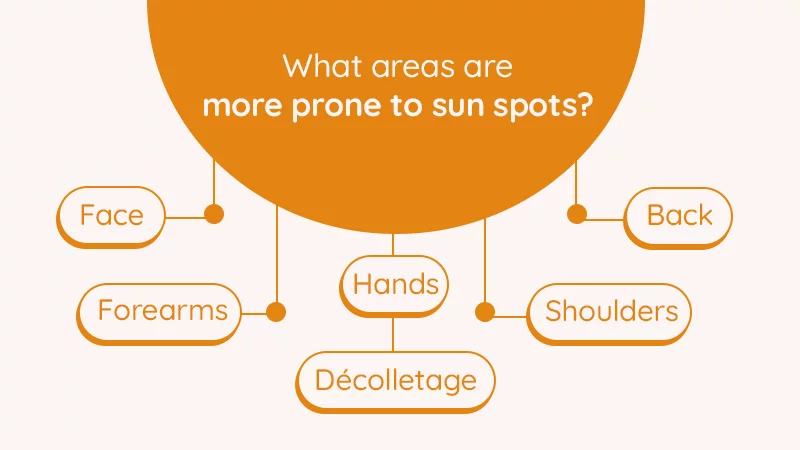
Sun spots tend to appear on areas of the skin that are more exposed to the sun over time. The following areas are commonly more prone to developing age spots:
- Face: The face is often one of the most exposed areas to sunlight, making it susceptible to sun damage and the formation of sun spots.
- Hands: Hands are frequently exposed to the sun and are often neglected when it comes to sunscreen application, leading to the development of these skin imperfections over time.
- Forearms: The forearms are another area that is frequently exposed to the sun, especially during outdoor activities, making them prone to sun spot formation.
- Décolletage: The chest area, known as the décolletage, is often exposed to the sun's harmful UV rays, increasing the likelihood of developing age spots in this area.
- Shoulders: Like the arms, the shoulders are commonly exposed to the sun, particularly in individuals who wear sleeveless clothing or spend time outdoors without adequate sun protection.
- Back: For individuals who spend time outdoors with their back exposed, such as during recreational activities or sunbathing, the back can also be prone to developing sun spots.
How to remove sun spots?
There are various professional and at-home remedies that can help diminish the appearance of age spots.
Topical treatments
- Hydroquinone: A skin-lightening agent that inhibits melanin production, helping to fade sun spots and hyperpigmentation.
- Retinoids (such as tretinoin): Promote cell turnover, exfoliate the skin, and improve the appearance of sun-damaged skin, including sun spots.
- Vitamin C: An antioxidant that can brighten the skin, fade age spots, and protect against further sun damage.
- Azelaic Acid: Helps to reduce melanin production and lighten dark spots, including age spots.
- Kojic acid: Derived from certain fungi, kojic acid inhibits melanin production and can fade age spots and hyperpigmentation.
- Licorice extract: Contains compounds that help to lighten dark spots and even out skin tone.
- Niacinamide (Vitamin B3): Helps to brighten the skin, improve uneven skin tone, and reduce the appearance of dark spots.
When using topical treatments to remove sun spots from the face and other areas, it is important to apply them as directed by a dermatologist or the product instructions. Consistent use, along with sun protection practices like wearing sunscreen and protective clothing, can help improve the appearance of pigmented spots over time.
Also Read: Why Is My Face Red? Possible Causes and Treatments
Chemical peels
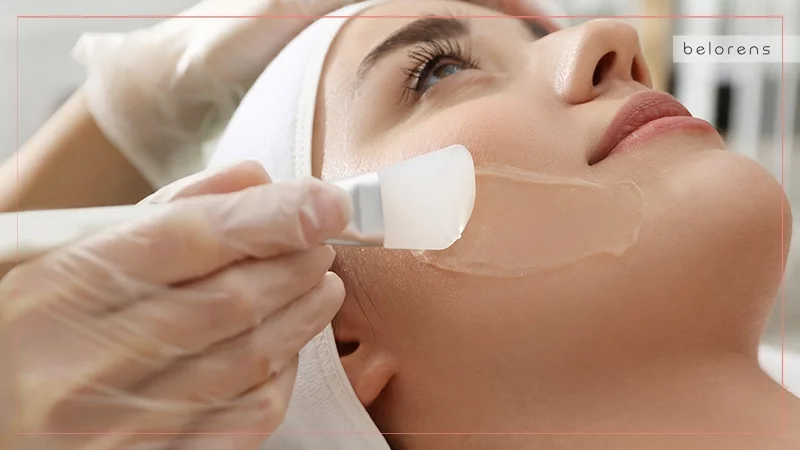
Chemical peels can be an effective treatment option for sun spots and uneven skin tone. Chemical peels involve the application of a chemical solution to the skin, which causes the top layers of the skin to exfoliate and peel off. This process reveals new skin underneath, which is typically smoother, less pigmented, and more even in tone.
Chemical peels can help improve the appearance of sun spots by exfoliating the pigmented outer layers of the skin. This can lead to a reduction in pigmentation and a more even skin tone over time. The results of a chemical peel for age spots can vary depending on the type of peel, the individual's skin type, and the severity of the problem. Multiple treatments may be needed to achieve desired results.
Laser therapy
Laser therapy is a popular and effective treatment option to remove age spots on hands, face, and other areas. Laser treatment uses concentrated beams of light to target and break down excess melanin in the skin, which causes sun spots and hyperpigmentation. The laser energy is absorbed by the pigmented cells, leading to their destruction and eventual fading.
Different types of lasers can be used for treating sun spots, including Q-switched lasers, fractional lasers, and intense pulsed light (IPL) devices. These lasers vary in wavelength and intensity, allowing for customized treatment based on the specific needs of the individual.
Laser therapy offers targeted treatment for age spots, resulting in a more even skin tone and reduced hyperpigmentation. It can also stimulate collagen production, leading to overall skin rejuvenation.
Results from laser therapy for age spots can be seen gradually over several weeks as the treated pigmented areas fade. Multiple treatment sessions may be required for optimal results, depending on the severity of the condition.
Cryotherapy
Cryotherapy is a common treatment option for sun spots and other types of skin lesions. It involves using liquid nitrogen or another freezing agent to freeze and destroy the targeted age spots. The extremely cold temperature causes the cells in the pigmented areas to freeze and die, leading to their eventual shedding and fading.
Cryotherapy can effectively target and remove age spots by destroying the excess pigmented cells. The treated areas may scab and peel off, revealing new, healthier skin with reduced pigmentation.
Sun spots treated with cryotherapy typically fade over time, with optimal results seen a few weeks after the treatment. Some individuals may require multiple cryotherapy sessions to achieve the desired outcome, depending on the depth and extent of the darkness.
Microdermabrasion
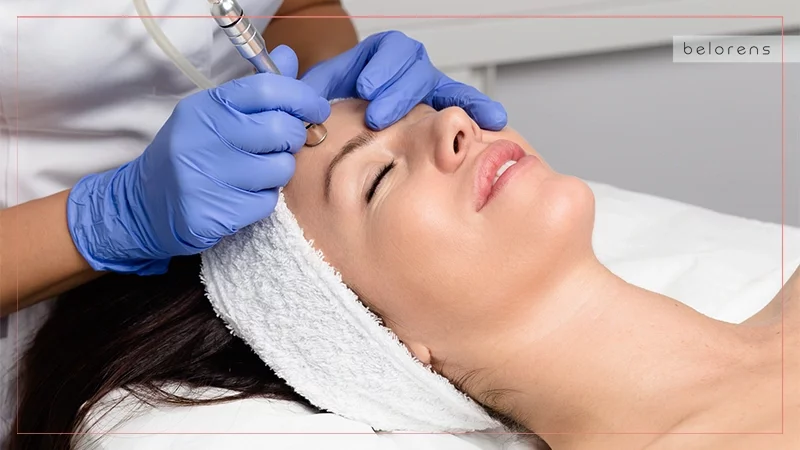
Dermabrasion
Dermabrasion is a cosmetic procedure that involves the removal of the top layers of skin to improve the appearance of sun spots, acne scars, and other skin irregularities. During a dermabrasion procedure for age spots, a dermatologist or trained healthcare provider will use a specialized device to carefully abrade the skin in the targeted areas where sun spots are present. This controlled exfoliation process helps to remove the damaged skin layers containing excess pigmentation.
Dermabrasion works by physically exfoliating the skin, stimulating the growth of new skin cells, and promoting a more even skin tone. By removing the outer layers of the skin, dermabrasion can help reduce the appearance of age spots and improve skin texture.
Results from dermabrasion for age spots can vary depending on the individual's skin type, the depth of treatment, and the number of sessions. The pigmented spots may lighten and become less noticeable as the skin heals and regenerates after dermabrasion.
How to treat sun spots naturally?
Natural remedies can help fade sun spots gradually and may complement professional treatments. Here are some natural at-home treatments to help reduce the appearance of age spots:
- Lemon juice: The citric acid in lemon juice has natural bleaching properties that can help lighten dark spots. Apply fresh lemon juice to the affected areas, leave it on for 10-15 minutes, then rinse off.
- Aloe vera: Aloe vera gel is known for its soothing and skin-repairing properties. Applying aloe vera gel to sun spots can help promote healing and reduce pigmentation.
- Apple cider vinegar: Diluted apple cider vinegar can act as a natural skin toner and may help lighten pigmented areas. Mix equal parts of apple cider vinegar and water, apply to the skin, leave on for a few minutes, then rinse off.
- Green tea extract: Green tea contains antioxidants that can help protect the skin and reduce hyperpigmentation. Applying cooled green tea to the skin or using skincare products containing green tea extract may help fade age spots on the face, hands, and other areas.
- Turmeric: Turmeric has anti-inflammatory and antioxidant properties that can benefit the skin. Create a paste using turmeric powder and water or honey, apply to sun spots, leave on for 15-20 minutes, then rinse off.
- Milk: The lactic acid in milk can help exfoliate the skin and lighten dark spots. Soak a cotton ball in milk and apply it to the affected areas, leave it on for 10-15 minutes, then rinse off.
- Rosehip oil: Rosehip oil is rich in vitamins and antioxidants that can help improve skin tone and texture. Applying rosehip oil to age spots regularly may help fade pigmentation over time.
It's important to note that natural remedies may take time to show results, and consistency is key. Additionally, it's essential to perform a patch test before trying any new natural remedy to ensure you do not have an adverse reaction. If sun spots persist or worsen, it's advisable to consult a dermatologist for professional guidance and treatment options.
How to prevent sun spots?
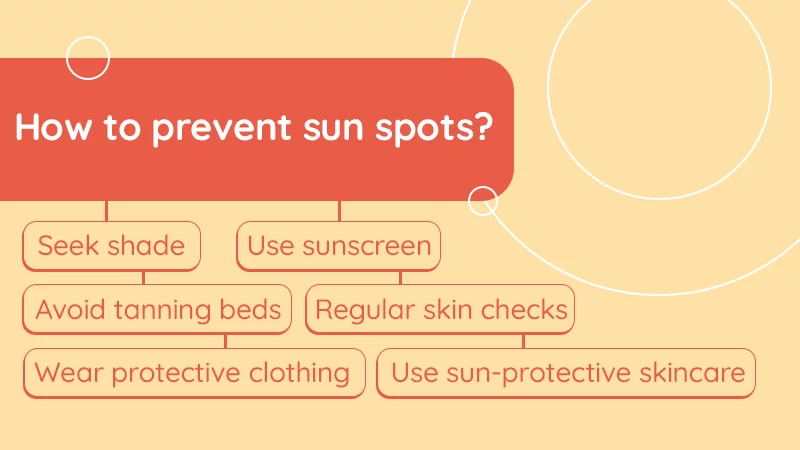
Preventing sun spots involves protecting your skin from the harmful effects of UV radiation. Here are some tips to help prevent age spots:
- Use sunscreen: Apply a broad-spectrum sunscreen with an SPF of 30 or higher every day, even on cloudy days. Reapply every two hours or more frequently if swimming or sweating.
Also Read: Sun Protection: All You Need to Know
- Seek shade: Limit your time in direct sunlight, especially between 10 a.m. and 4 p.m. when the sun's rays are strongest.
- Wear protective clothing: Cover up with clothing, hats, and sunglasses to shield your skin from the sun.
- Avoid tanning beds: Tanning beds emit harmful UV radiation that can contribute to the formation of sun spots and skin damage.
- Use sun-protective skincare: Incorporate skincare products with antioxidants and ingredients like vitamin C and niacinamide to help protect the skin from UV damage.
- Regular skin checks: Monitor your skin for any changes, including new or changing spots, and consult a dermatologist if you notice anything unusual.
By following these sun protection measures and being mindful of sun exposure, you can reduce your risk of developing age spots and maintain healthy, radiant skin.
Are age spots dangerous?
Sun spots are usually harmless and do not pose a serious health risk. They are typically benign, non-cancerous skin lesions that develop as a result of prolonged sun exposure over time.
That said, age spots are considered a sign of sun damage and can indicate an increased risk of developing skin cancer, especially if they are irregular in shape, have uneven borders, or exhibit changes in color or size, so you should monitor pigmented areas for any changes and have them evaluated by a dermatologist if there are concerns.
It is important to differentiate between benign dark spots and potentially malignant skin lesions, such as melanoma. Regular skin self-examinations and professional skin checks can help detect any suspicious changes in sun spots or new skin growths that may require further evaluation.
In summary, while age spots themselves are not typically serious skin conditions, they can serve as a reminder of sun exposure and skin damage. Monitoring sun spots for changes, practicing sun-safe behaviors, and seeking medical advice if there are concerns about skin changes are important steps in maintaining skin health and reducing the risk of potential skin issues, including skin cancer.
When should I see a doctor for sun spots?
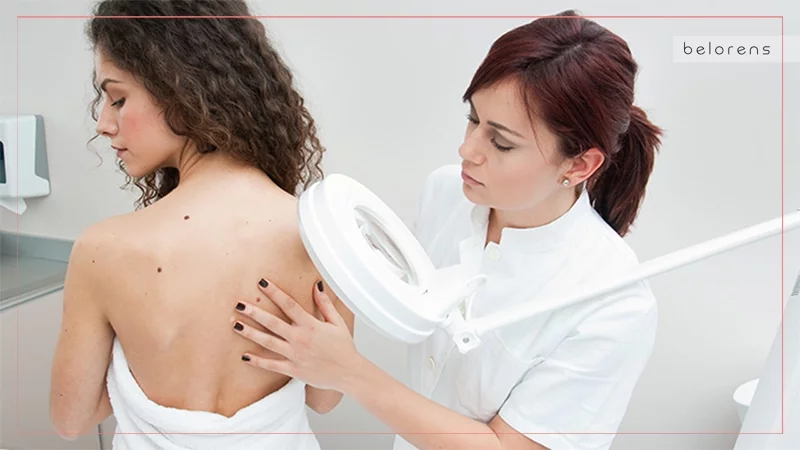
It is advisable to consult a doctor or dermatologist if you have sun spots under the following circumstances:
- Change in appearance: If you notice any changes in the size, shape, color, or texture of your age spots, it is essential to seek medical evaluation. Any new or evolving spots should be examined by a healthcare provider to rule out skin conditions like melanoma.
- Rapid growth: Aun spots that rapidly increase in size or darken over a short period should be evaluated by a doctor. Sudden changes in sun spots may indicate a more serious skin issue that requires prompt attention.
- Itching or bleeding: Sun spots that itch, bleed, or become painful should be assessed by a healthcare professional. These symptoms could be signs of skin irritation, infection, or other underlying skin conditions that need medical intervention.
- Concerns about skin cancer: If you have a history of skin cancer, a family history of skin cancer, or other risk factors, it is important to have your dark skin spots checked regularly by a dermatologist for early detection and timely treatment.
- Persistent sun spots: If your age spots do not respond to over-the-counter treatments or natural remedies and continue to be bothersome or cosmetically concerning, consulting a doctor for professional advice and treatment options is recommended.
- Preventive skin checks: Regular skin checks with a dermatologist are recommended for individuals with a history of sun exposure, sun damage, or skin cancer risk factors. Routine skin examinations can help detect any changes in sun spots early on and address them appropriately.
Overall, if you have any concerns about your sun spots, it is best to err on the side of caution and schedule an appointment with a specialist for a thorough skin evaluation. Early detection and proper management of age spots can help ensure skin health and address any underlying skin issues effectively.




